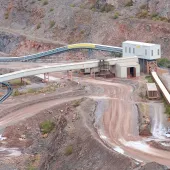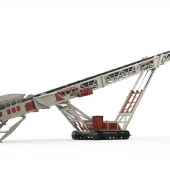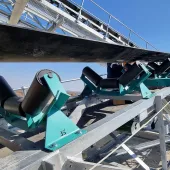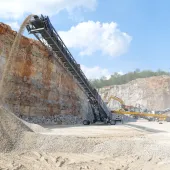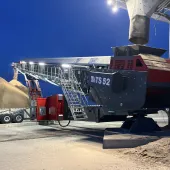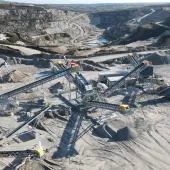New Technologies Improve Conveyor Efficiency and Safety

First published in the April 2021 issue of Quarry Management as Designing for Safety
Martin Engineering outline a new approach to belt conveyors
Conveyors are among the most dynamic and potentially dangerous areas of equipment at any quarry or material processing site. Even though their safety and performance are critical to the operation’s success, the impact of their contribution to overall efficiency sometimes goes unrecognized by management and workers alike. The operational basics of belt conveyor systems are often a mystery to those employees who have little understanding about the hardware installed and the performance required from the components.
This knowledge gap is understandable. The attention of personnel at a mine or quarry operation is centred on the processing of the company’s main product. The ‘care and feeding’ of belt conveyors – ie the adjustment, maintenance and troubleshooting that can make a huge difference in safety, performance and profitability – may be outside of their expertise and the ongoing maintenance and service of these systems is often not part of their immediate focus or within their time constraints.
In addition, there is often a failure of the retiring workforce to pass on the wisdom they have gained over the years, and the ‘missing generation’ in mining-related jobs has only served to exacerbate that knowledge gap. Although interest in mine and quarry engineering seems to have regained some ground in recent years, there still a general shortage of people in the 25–45 age range.
Protecting the most valuable assets
‘Personnel are the single most important resource of any mine or quarry operation, and engineers and designers are incorporating greater functionality into designs that will improve safety,’ observed Martin Engineering’s chief technology officer, Paul Harrison. ‘Standards continue to tighten, and the US Mine Safety and Health Administration (MSHA) retains a strong focus on worker safety, driving the need for equipment designs that are not just safe, but optimized for safety – that is, designed with safety as a fundamental priority. At the same time, there is increasing pressure for continuous and ever-increasing production.’
To meet the demands for greater safety and improved production, some manufacturers have introduced equipment designs that are not only engineered for safer operation and servicing, but also for reduced maintenance time. One example is a new family of heavy-duty conveyor belt cleaners, designed so the blade cartridge can be pulled away from the belt for safe access and replaced by a single worker.
The same slide-out technology has been applied to impact cradle designs. The systems are engineered so operators can work on the equipment safely, without breaking the plane of motion. ‘External servicing reduces confined space entry and eliminates reach-in maintenance, while facilitating faster replacement. The result is greater safety and efficiency, with less downtime,’ said Mr Harrison.
Another example is a revolutionary new belt cleaner design that can reduce the need for bulky urethane blades altogether, an innovative belt cleaning system that has received the Australian Bulk Handling Award in the ‘Innovative Technology’ category for its design and potential benefits. The patented design delivers extended service life, low belt wear, significantly reduced maintenance and improved safety, ultimately delivering lower cost of ownership.
‘Unlike conventional belt cleaners that are mounted at an angle to the belt, this unique cleaner is installed diagonally across the discharge pulley, forming a three-dimensional curve beneath the discharge area that conforms to the pulley’s shape,’ explained Martin Engineering’s conveyor products manager, Dave Mueller. ‘The design incorporates a matrix of tungsten carbide scrapers and is tensioned lightly against the belt to prevent damage to the belt or splices.’
Despite extremely low contact pressure between belt and cleaner, it has been shown to remove as much as 95% of potential carryback material. The novel approach has been so effective that in many operations, previously crucial secondary belt cleaners have become unnecessary, saving further on belt cleaning costs and service time.
Power
Another trend in large operations is a need for enhanced automation and monitoring, including such tasks as load sensing, belt tracking, cleaner tensioning and lighting. ‘In most cases, electrical power is supplied only to the conveyor locations where it’s needed, such as the drive motor, and is not typically available for general purpose use,’ continued Paul Harrison. ‘In many operations, this lack of available power means that any monitoring of the conveyor must be done by technicians physically walking the length of the structure, which can be a difficult and time-consuming task when the systems are long and span difficult terrain.’
A more efficient approach is to employ sensors to transmit important data from remote points to a central location where they can be monitored in real time and recorded for later analysis. But intelligent monitoring systems for any conveyor system require power for extended operation. Due to the distances involved, cabled communication systems are not ideal, and therefore wireless communication systems are more advantageous. Options such as solar are not well suited to the general conditions of a conveyor system, as monitoring devices are often required in an enclosed structure without access to sunlight, or for continuous operation during both day and night.
A conveyor is driven by a multi-kilowatt motor, and this power is readily available system-wide in the form of the moving belt. The motors driving the belts are typically sized with a considerable power safety factor to account for parasitic loads, such as rolls with damaged bearings, tracking devices (which may work almost continuously), sealing systems, belt cleaners and material changes due to different moisture levels and variable loads. For these reasons, engineers have searched for ways to take advantage of the available kinetic energy of the moving belt to bring power to the specific places where sensors and other devices would provide advantages.
In most conveyor designs, the belt runs on a set of rollers that provide support and guide the belt. The typical conveyor roller is a very reliable device, with key components such as bearings, seals and the ‘steel can’ all well understood in the industry. Product designers theorized that they could draw power from a moving belt by attaching an independent generator directly to one of the rollers. In this way, they felt that power could be drawn from the conveyor without altering the structure of the system or affecting its physical configuration.
‘Being able to add a generator to a roller delivers the benefit of utilizing the proven reliability of existing roller designs, while drawing power from the belt for a wide variety of electronic devices,’ said Dave Mueller. The goal was to engineer a device with the versatility to retrofit existing idler designs, so operators would not be required to maintain a special stock of conveyor rollers, as the generator could be employed on virtually any steel roller.
Product engineers developed a design to accomplish this through the use of a magnetic coupling that attaches to the end of an existing roller. ‘The outside diameter of the generator matches the diameter of the roll but places the generator outside the normal belt line to avoid the heavy loads and fugitive material that tends to damage existing design attempts,’ added Mr Mueller. ‘The generator is held in a fixed position by the roll support system but is not normally required to bear any of the material load.’
The reliable power supply helps bring a new level of sophistication to conveyors, allowing designers to equip their systems with devices such as weigh scales, proximity switches, moisture sensors, pressure switches, solenoids and relays, as well as timers, lights and even additional safety mechanisms. Wireless communication can be used to transmit directly to a central controller, giving operators a cost-effective way to access data that has not been readily available in the past and taking another step toward ‘smarter’ conveyor systems.
In a related move toward safer, more productive material handling, one global conveyor technology innovator has introduced an automated pneumatic tensioning system for belt cleaners. The new device delivers precise monitoring and tensioning throughout all stages of blade life, minimizing the labour typically required to maintain optimum blade pressure and extending the service life of both the belt and the cleaner. Equipped with sensors to confirm that the belt is loaded and running, the system automatically backs the blade away during stoppages or when the conveyor is running empty, minimizing unnecessary wear to both the belt and cleaner. The result is consistently correct blade tension, with reduced power demand on start-up, all managed without human intervention.
Continuous improvement
With properly trained staff and thoughtfully designed components, conveyor maintenance is becoming easier and safer than ever before. Thanks to new component designs and advanced engineering capabilities, the work environment has been drastically improved in recent years, and operators are reducing downtime due to clean-up and broken equipment. These gains should inspire operators to make time for a cost/benefit analysis of new technologies and assess the long-term gains of both increased efficiency and workplace safety.
‘Managers concerned with the overall safety and cost of operation need to go through the numbers to see how the impact of rising labour costs for clean-up and maintenance, combined with the expense of potential fines or forced downtime, can affect the bottom line,’ concluded Paul Harrison. Using new and emerging technologies such as the ones described here, even poorly performing conveyors often do not need to be replaced or rebuilt, but merely modified and reconfigured by knowledgeable and experienced technicians installing modern equipment. These improvements will help operations improve efficiency, reduce risk and contribute to regulatory compliance.
- Subscribe to Quarry Management, the monthly journal for the mineral products industry, to read articles before they appear on Agg-Net.com


